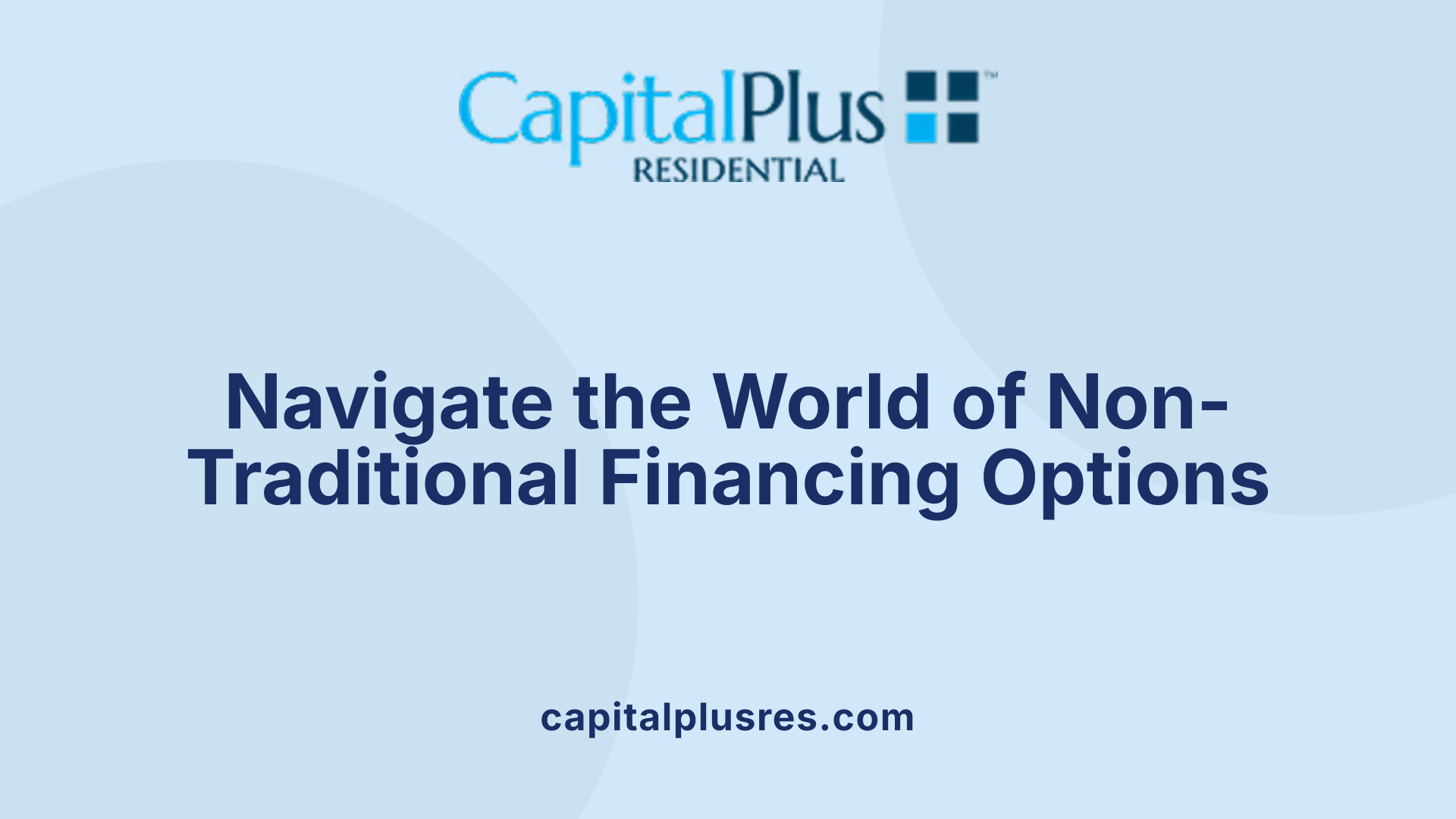Rethinking Real Estate Funding Options to Match Unique Needs
In today's dynamic real estate market, investors and buyers are increasingly turning to creative refinancing strategies to overcome traditional obstacles, seize more opportunities, and tailor financial solutions to their specific circumstances. This article explores various inventive approaches, the diverse sources available, their benefits, and best practices for applying these strategies across different scenarios.
Understanding the Landscape of Creative Real Estate Finance

What are the sources, benefits, and guidelines for inventive financing solutions in real estate?
Creative financing in real estate refers to non-traditional methods of funding property purchases that differ from conventional bank mortgages. These alternative sources include seller financing, lease options, hard money loans, private lending, crowdfunding, and leveraging existing property equity or retirement funds.
The primary advantage of these strategies is their flexibility. They often allow quicker access to capital and require less upfront money compared to traditional loans. This makes real estate investments more accessible, especially for buyers with credit issues or limited initial capital.
Common creative financing methods include:
- Seller Financing: The seller acts as the lender, offering flexible repayment terms.
- Lease Options: The tenant has the option to buy the property later, providing control without immediate ownership.
- Hard Money Loans: Short-term, private loans secured by the property, suitable for quick deals.
- Private Lending: Borrowing from individuals like family, friends, or private investors with negotiated terms.
- Crowdfunding: Raising small amounts of capital from many investors online.
- Leveraging Property Equity: Using tools like HELOCs or self-directed IRAs to fund new investments.
Each source comes with its own set of considerations concerning legal protections, risk assessment, and compliance. For instance, contracts like promissory notes, legal agreements such as novation, or partnership structures often underpin these deals.
Implementing inventive financing solutions requires thorough understanding of legal implications, repayment obligations, and risk management strategies. Transparency with all parties and adherence to regulations are vital to successful and sustainable deals.
In conclusion, these diverse sources and methods expand investment possibilities, allowing investors to tailor funding to their unique situations, manage cash flow effectively, and adapt to changing market conditions.
Diverse Sources of Non-Conventional Funding in Real Estate

What are some alternative and non-traditional funding options available for real estate refinancing?
When traditional bank loans are not feasible or desirable, real estate investors turn to a variety of alternative financing sources. These non-conventional methods can offer greater flexibility, faster access to capital, and tailored terms suited to unique investment scenarios.
One prominent option is private lenders and hard money loans. Private lenders are individuals or private entities willing to lend funds based on the property's value rather than the borrower's creditworthiness. Hard money loans are short-term, asset-secured loans from private investors, often used for quick acquisitions or fix-and-flip projects.
Crowdfunding platforms and syndicates also play a significant role. They pool small investments from numerous supporters, enabling investors to participate in large projects with lower individual capital requirements. This approach democratizes access to real estate investments and allows for diversification.
Seller financing and lease-to-own agreements provide flexible purchase terms. Seller financing involves the seller acting as the lender, financing the property directly to the buyer, which can be especially useful in distressed or low-equity situations. Lease options give tenants the right to buy after a rental period, providing a pathway for those who need time to secure traditional financing.
Government-backed programs are another vital resource. FHA, VA, USDA, and SBA loans offer favorable terms, lower down payments, or special eligibility criteria. These programs can make homeownership or commercial property investment more accessible for qualified borrowers.
Finally, innovative financing through retirement accounts such as IRAs can enable investors to fund real estate deals without traditional banks. Self-directed IRAs permit investing in properties directly, offering potential tax advantages and portfolio diversification.
Utilizing these diverse financing options requires careful planning and understanding of each method's specific requirements, risks, and benefits. They can unlock opportunities that traditional financing cannot, especially in markets with high competition or unconventional properties.
Below is a summary table of various non-conventional funding sources and their features:
| Funding Source | Typical Use Case | Benefits | Considerations |
|---|---|---|---|
| Private lenders & Hard Money | Quick acquisitions or rehab projects | Fast approval, less documentation, asset-based loans | Higher interest rates, short-term focus |
| Crowdfunding & Syndicates | Large or diverse projects | Lower entry barriers, shared risk | Regulatory and platform fees |
| Seller Financing | Buying properties from motivated sellers | Flexible terms, low upfront costs | Seller's willingness, due diligence needed |
| Lease-to-Own/Options | Buyers needing time to qualify | Entry to ownership, rent credits | Market risk, option fees |
| Government-backed loans | Residential and commercial projects | Lower down payments, favorable terms | Strict qualification criteria |
| Retirement Fund Financing | Long-term portfolios | Tax advantages, diversified investment | Self-direction required, IRS regulations |
Exploring these options can significantly expand an investor's toolkit, enabling more flexible, strategic investments, especially when conventional loans are inaccessible or restrictive.
Tailoring Creative Strategies to Specific Investment Needs

What are different creative financing methods tailored to specific or unique needs in real estate?
In real estate investing, flexible and innovative financing options can significantly expand opportunities. Seller financing and lease options are among the most versatile strategies, allowing buyers to acquire properties without traditional bank loans. Seller financing involves the seller acting as the lender, with the buyer making payments over time, often with favorable terms. Lease options, or rent-to-own arrangements, give tenants control of a property with an option to purchase later, appealing to those who need time to improve credit or save for a down payment.
Other methods include taking over existing mortgages through 'Subject To' agreements, where the buyer payments the seller's mortgage without qualifying for a new loan. Cross collateralization is another tool, where multiple properties are used to secure a loan, providing additional security for lenders.
Borrowers can also leverage their home equity via Home Equity Lines of Credit (HELOCs) or cash-out refinances to fund new investments. Partnering through joint ventures pools resources, sharing risks and profits for larger or more diverse projects.
Government-backed loans such as FHA, VA, and USDA programs often come with lower down payment requirements or more flexible qualification standards, making them ideal for investors with limited initial capital. Crowdfunding platforms provide a means to raise funds from many supporters, while grants can fund specific projects or initiatives focused on community development.
Using a self-directed IRA allows investors to use retirement funds for property purchases, promoting diversification and tax advantages. Land trusts offer privacy and protection of ownership, useful in certain strategic scenarios.
These approaches are especially useful when traditional financing isn’t an option—such as in distressed sales, preforeclosures, or high-value investments—tailored to meet the unique circumstances of each deal. Understanding and applying these methods can open doors to real estate investing success that conventional loans might block.
| Strategy Type | Description | Best Use Case | Additional Notes |
|---|---|---|---|
| Seller Financing | Seller acts as lender, buyer pays over time | Free and clear properties | Flexible terms, may involve interest-free deals |
| Lease Option | Rent-to-own with purchase option | Buyers needing time to qualify | Rent credits can build equity |
| Subject To | Take over existing mortgage payments | Preforeclosure or low equity deals | Risk if seller's due-on-sale clause activates |
| Cross Collateralization | Multiple properties secure one loan | Larger investments | Complexity requires careful legal setup |
| HELOC / Cash-Out | Leverage home equity for new funding | Quick access to cash | Increases debt but offers flexible capital |
| Joint Ventures | Partner with other investors | Larger or more diverse projects | Share risks and rewards |
| Government Loans | FHA, VA, USDA with lower down payments | Limited upfront capital | Vary by property type and location |
| Crowdfunding | Raise small amounts from many supporters | Community projects or startups | Requires compelling story |
| Grants | Non-repayable funding for specific use | Community, social, or affordable housing | Competitive process |
| Self-Directed IRA | Use retirement funds for investments | Diversify retirement portfolio | Must follow IRS rules for investments |
| Land Trusts | Hold property ownership for privacy | Strategic or niche investments | Legal advice recommended |
By applying these adapted strategies, investors can tailor their approaches to fit specific investment goals, financial situations, and market conditions, enabling more flexible and creative real estate endeavors.
Applying Creative Financing in Various Market Scenarios

How can creative refinancing strategies be applied to different scenarios in real estate?
Creative financing methods offer valuable solutions across a range of real estate market situations, especially when traditional avenues are limited or less advantageous.
For individuals with low credit scores or limited liquidity, techniques like seller financing and lease options provide flexible purchase arrangements. Seller financing involves the seller acting as the lender, often with favorable terms such as reduced or zero interest, making it accessible for buyers who might struggle to qualify for bank loans. Lease options allow tenants to control a property and secure the right to buy later, offering time to improve credit or save for down payments.
In cases involving distressed properties or pre-foreclosures, the 'Subject To' strategy becomes beneficial. It entails taking over existing mortgage payments without the need for new financing, helping investors acquire properties with minimal upfront costs. This approach is especially useful when the property has low equity or the existing loan has favorable terms.
For quick acquisitions or projects requiring rapid funding, hard money loans and private money lending are preferred. These short-term, asset-secured loans from private investors or lenders bypass lengthy bank approval processes, making them ideal for time-sensitive deals or properties needing urgent renovations.
Diversification of funding sources is also crucial. Utilizing government-backed programs such as FHA, VA, or USDA loans can reduce down payments and offer more lenient qualification standards. Additionally, crowdfunding platforms and self-directed IRAs enable investors to pool resources or invest retirement funds into real estate, broadening options beyond traditional loans.
Altogether, these creative refinancing and financing strategies allow investors to adapt to different market environments, overcome barriers, and optimize their property management and investment outcomes. They facilitate access to properties otherwise difficult to acquire, support quick turnarounds, and help diversify investment portfolios for sustained growth.
Innovative and Flexible Refinancing Techniques for Investment Success
What are some innovative and flexible refinancing strategies for real estate investments?
Investors seeking to maximize their real estate return often look beyond traditional financing options. Creative financing methods provide greater flexibility and open up new opportunities for acquiring and managing properties. One popular approach is seller financing, where the property seller acts as the lender, allowing for more adaptable repayment terms like interest-only payments or deferred payments. This is particularly advantageous with properties owned free and clear or in low-interest scenarios.
Another flexible strategy involves short-term tools suited for investment periods of 2 to 8 years. Hard money loans and private money lending are ideal here. Hard money loans are asset-backed, quick to arrange, and often used for fix-and-flip projects due to their fast approval process. Private lenders, such as family or individual investors, provide tailored terms that bypass the lengthy approval processes of traditional banks.
Legal considerations also play a critical role. Structuring deals through trusts can help mitigate risk, especially related to due-on-sale clauses, which could be triggered if the property changes hands unexpectedly. Utilizing legal structures provides a safeguard against contractual issues and enhances privacy.
To efficiently manage these complex transactions, investors turn to advanced tools and software like REsimpli. Such platforms assist in tracking deal progress, managing payment schedules, storing essential documentation, and maintaining clear communication among all involved parties. This technological support reduces mismanagement and helps investors swiftly adapt to market dynamics.
In summary, embracing these innovative and flexible refinancing techniques—ranging from seller financing to short-term hard money loans, coupled with sound legal planning and robust management tools—can significantly enhance an investor's ability to capitalize on real estate opportunities with agility and confidence.
| Strategy Type | Description | Best Use Cases | Additional Details |
|---|---|---|---|
| Seller Financing | Seller acts as lender, providing flexible payment options | Free and clear properties, creative lease structures | Often involves principal-only payments, no bank approval needed |
| Hard Money Loans | Private, short-term loans secured by property | Quick flips, bridge financing | Faster approval, higher interest rates, short-term focus |
| Private Money Lending | Borrowing from individuals or groups | Flexible terms, fast access | Suitable for quick turnaround projects |
| Trusts & Legal Structures | Establishing legal entities to reduce risk | Mitigating due-on-sale clauses, estate planning | Consultation with legal professionals recommended |
| Management Software | Platforms like REsimpli for deal tracking | Complex deal coordination | Facilitates documentation, payment schedules, and communication |
Understanding and utilizing these creative financing options allow investors to adapt to market challenges, minimize upfront costs, and pursue a wider range of investment opportunities confidently.
Legal and Practical Considerations in Creative Financing

What are the legal considerations for inventive financing solutions in real estate?
Implementing creative financing strategies in real estate involves navigating various legal factors that are crucial for protecting investors and ensuring transactions comply with regulations. One of the major concerns is the due-on-sale clause, common in most mortgage agreements, allowing lenders to demand full repayment if the property changes hands without their approval. This risk can be managed effectively by using legal structures such as trusts, which can obscure the transfer of property and help keep the original loan in place without triggering the clause.
Legal documentation plays a vital role in clarifying the terms and securing enforceability. Agreements like promissory notes, contracts for deed, lease options, or novation agreements should be meticulously drafted to prevent misunderstandings or legal loopholes. This documentation ensures all parties are aware of their rights and obligations, minimizing disputes.
Understanding and adhering to local regulations and compliance standards is essential, especially since creative deals often involve complex arrangements that may attract regulatory scrutiny. Legal professionals with expertise in real estate law can provide invaluable guidance, helping investors stay within legal boundaries.
Partnering with experienced legal and tax advisors is strongly recommended to tailor the financing structures to specific goals while navigating potential pitfalls. These professionals can assist in optimizing deal structures, managing risks, and ensuring that all legal requirements are met. In summary, transparency, thorough documentation, and professional collaboration are fundamental components for successfully executing creative real estate finance strategies.
Navigating Innovation with Knowledge and Care
Creative refinancing strategies unlock diverse opportunities in the real estate market, especially for investors facing unique challenges or seeking tailored solutions. By understanding the various sources, benefits, and legal considerations, investors can craft solutions that are both innovative and compliant, maximizing their potential for success. The key lies in thorough research, strategic planning, and working closely with experienced professionals to ensure that these inventive approaches yield sustainable and profitable results.
References
- 12 Creative Financing Strategies for Real Estate Investing
- Creative Financing 101: Beyond Traditional Deals
- Unlock Creative Financing For Commercial Real Estate ...
- Creative Financing Strategies for Real Estate Investors
- How Creative Financing Can Get You Deals in Any Market
- Innovative Funding Strategies for Entrepreneurs
- Creative Financing Strategies for Real Estate Investors
- 12 Creative Financing Strategies for Real Estate Investing
- Creative Financing Real Estate 2025: Crowdfunding, ...
- Thinking outside the bank: A guide to creative financing
Latest Blog


Get Pre-Approved Today
Start your secure online application now so you can get pre-approved for a mortgage (and close on your dream home) quickly within 5 minutes.









